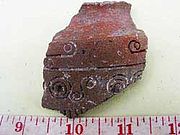
Maitum Anthropomorphic Potteries
Encyclopedia

In 1991, archeologists discovered anthropomorphic secondary burial jars in Ayub Cave, Piñol. Maitum
Maitum, Sarangani
Maitum is a 2nd class municipality in the province of Sarangani, Philippines. According to the latest census, it has a population of 37,054 people in 7,640 households....
, Sarangani Province
Sarangani
In 1945, Filipino troops of the 6th, 10th, 101st and 102nd Infantry Division of the Philippine Commonwealth Army and 10th Infantry Regiment of the Philippine Constabulary entered and liberated in Southern Cotabato In 1945, Filipino troops of the 6th, 10th, 101st and 102nd Infantry Division of the...
, in Mindanao
Mindanao
Mindanao is the second largest and easternmost island in the Philippines. It is also the name of one of the three island groups in the country, which consists of the island of Mindanao and smaller surrounding islands. The other two are Luzon and the Visayas. The island of Mindanao is called The...
, Philippines
Philippines
The Philippines , officially known as the Republic of the Philippines , is a country in Southeast Asia in the western Pacific Ocean. To its north across the Luzon Strait lies Taiwan. West across the South China Sea sits Vietnam...
. Since this sensational finding, a number of archaeological excavations were conducted to recover these important artifacts
Artifact (archaeology)
An artifact or artefact is "something made or given shape by man, such as a tool or a work of art, esp an object of archaeological interest"...
. These excavation projects were either government or privately sponsored.
These burial jars are made of earthenware and characterized by their design and form that looks like or suggests human figures with complete or partial facial characteristics. These are earthenware
Earthenware
Earthenware is a common ceramic material, which is used extensively for pottery tableware and decorative objects.-Types of earthenware:Although body formulations vary between countries and even between individual makers, a generic composition is 25% ball clay, 28% kaolin, 32% quartz, and 15%...
potteries
Pottery
Pottery is the material from which the potteryware is made, of which major types include earthenware, stoneware and porcelain. The place where such wares are made is also called a pottery . Pottery also refers to the art or craft of the potter or the manufacture of pottery...
with incisions and cut-out foot-rings. These humanlike forms were associated with metal implements like bracelet
Bracelet
A bracelet is an article of jewelry which is worn around the wrist. Bracelets can be manufactured from metal, leather, cloth, plastic or other materials and sometimes contain jewels, rocks, wood, and/or shells...
s. Some jar
Jar
A jar is a rigid, approximately cylindrical container with a wide mouth or opening. Jars are typically made of glass, ceramic, or plastic. They are used for foods, cosmetics, medications, and chemicals that are relatively thick or viscous...
s are decorated with glass beads
Glass beadmaking
The technology for glass beadmaking is among the oldest human arts, dating back 3,000 years . Glass beads have been dated back to at least Roman times...
and shell scoop
Scoop (utensil)
In common usage, a scoop is any specialized spoon used to serve food.In the technical terms used by the food service industry and in the retail and wholsale food utensil industries, there is a clear distinction between two types of scoop: the disher, which is used to serve ice cream, measure a...
, spoon
Spoon
A spoon is a utensil consisting of a small shallow bowl, oval or round, at the end of a handle. A type of cutlery , especially as part of a place setting, it is used primarily for serving. Spoons are also used in food preparation to measure, mix, stir and toss ingredients...
, and pendant
Pendant
A pendant is a loose-hanging piece of jewellery, generally attached by a small loop to a necklace, when the ensemble may be known as a "pendant necklace". A pendant earring is an earring with a piece hanging down. In modern French "pendant" is the gerund form of “hanging”...
s. Among the anthropomorphic vessels are plain non-anthropomorphic burial jars.
According to scientists, these secondary burial jars date back to the Metal Age. The artifacts were dated to 830 +/-60 B.P. (by a calibrated date of AD 70 to 370) and 1920 +/- 50 B.P. (by a calibrated date of 5 BC to 225 AD). Scientists determined the age of the jars by doing radiocarbon date
Radiocarbon dating
Radiocarbon dating is a radiometric dating method that uses the naturally occurring radioisotope carbon-14 to estimate the age of carbon-bearing materials up to about 58,000 to 62,000 years. Raw, i.e. uncalibrated, radiocarbon ages are usually reported in radiocarbon years "Before Present" ,...
tests on the soot samples taken from a small earthenware vessel. This small vessel was found inside one of the larger burial jar.
Related news items


